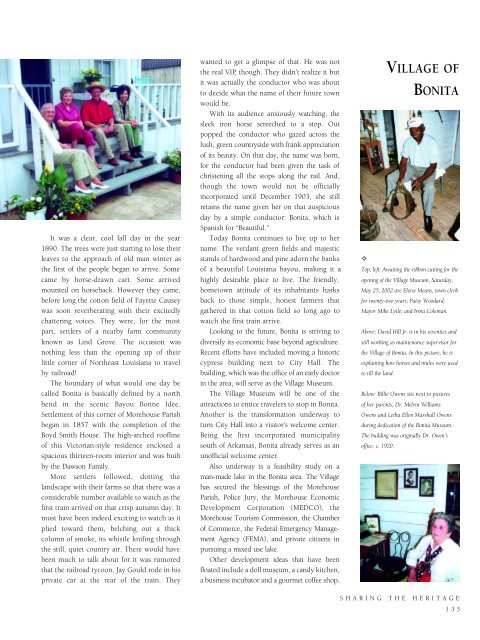Historic Louisiana
An illustrated history of Louisiana, paired with the histories of companies, families and organizations that make the state great.
An illustrated history of Louisiana, paired with the histories of companies, families and organizations that make the state great.
Create successful ePaper yourself
Turn your PDF publications into a flip-book with our unique Google optimized e-Paper software.
It was a clear, cool fall day in the year<br />
1890. The trees were just starting to lose their<br />
leaves to the approach of old man winter as<br />
the first of the people began to arrive. Some<br />
came by horse-drawn cart. Some arrived<br />
mounted on horseback. However they came,<br />
before long the cotton field of Fayette Causey<br />
was soon reverberating with their excitedly<br />
chattering voices. They were, for the most<br />
part, settlers of a nearby farm community<br />
known as Lind Grove. The occasion was<br />
nothing less than the opening up of their<br />
little corner of Northeast <strong>Louisiana</strong> to travel<br />
by railroad!<br />
The boundary of what would one day be<br />
called Bonita is basically defined by a north<br />
bend in the scenic Bayou Bonne Idée.<br />
Settlement of this corner of Morehouse Parish<br />
began in 1857 with the completion of the<br />
Boyd Smith House. The high-arched roofline<br />
of this Victorian-style residence enclosed a<br />
spacious thirteen-room interior and was built<br />
by the Dawson Family.<br />
More settlers followed, dotting the<br />
landscape with their farms so that there was a<br />
considerable number available to watch as the<br />
first train arrived on that crisp autumn day. It<br />
must have been indeed exciting to watch as it<br />
plied toward them, belching out a thick<br />
column of smoke, its whistle knifing through<br />
the still, quiet country air. There would have<br />
been much to talk about for it was rumored<br />
that the railroad tycoon, Jay Gould rode in his<br />
private car at the rear of the train. They<br />
wanted to get a glimpse of that. He was not<br />
the real VIP, though. They didn’t realize it but<br />
it was actually the conductor who was about<br />
to decide what the name of their future town<br />
would be.<br />
With its audience anxiously watching, the<br />
sleek iron horse screeched to a stop. Out<br />
popped the conductor who gazed across the<br />
lush, green countryside with frank appreciation<br />
of its beauty. On that day, the name was born,<br />
for the conductor had been given the task of<br />
christening all the stops along the rail. And,<br />
though the town would not be officially<br />
incorporated until December 1903, she still<br />
retains the name given her on that auspicious<br />
day by a simple conductor: Bonita, which is<br />
Spanish for “Beautiful.”<br />
Today Bonita continues to live up to her<br />
name. The verdant green fields and majestic<br />
stands of hardwood and pine adorn the banks<br />
of a beautiful <strong>Louisiana</strong> bayou, making it a<br />
highly desirable place to live. The friendly,<br />
hometown attitude of its inhabitants harks<br />
back to those simple, honest farmers that<br />
gathered in that cotton field so long ago to<br />
watch the first train arrive.<br />
Looking to the future, Bonita is striving to<br />
diversify its economic base beyond agriculture.<br />
Recent efforts have included moving a historic<br />
cypress building next to City Hall. The<br />
building, which was the office of an early doctor<br />
in the area, will serve as the Village Museum.<br />
The Village Museum will be one of the<br />
attractions to entice travelers to stop in Bonita.<br />
Another is the transformation underway to<br />
turn City Hall into a visitor’s welcome center.<br />
Being the first incorporated municipality<br />
south of Arkansas, Bonita already serves as an<br />
unofficial welcome center.<br />
Also underway is a feasibility study on a<br />
man-made lake in the Bonita area. The Village<br />
has secured the blessings of the Morehouse<br />
Parish, Police Jury, the Morehouse Economic<br />
Development Corporation (MEDCO), the<br />
Morehouse Tourism Commission, the Chamber<br />
of Commerce, the Federal Emergency Management<br />
Agency (FEMA), and private citizens in<br />
pursuing a mixed use lake.<br />
Other development ideas that have been<br />
floated include a doll museum, a candy kitchen,<br />
a business incubator and a gourmet coffee shop.<br />
VILLAGE OF<br />
BONITA<br />
✧<br />
Top, left: Awaiting the ribbon cutting for the<br />
opening of the Village Museum, Saturday,<br />
May 25, 2002 are Eloise Means, town clerk<br />
for twenty-two years; Patsy Woodard;<br />
Mayor Mike Lytle; and Irma Coleman.<br />
Above: David Hill Jr. is in his seventies and<br />
still working as maintenance supervisor for<br />
the Village of Bonita. In this picture, he is<br />
explaining how horses and mules were used<br />
to till the land.<br />
Below: Billie Owens sits next to pictures<br />
of her parents, Dr. Melvin Williams<br />
Owens and Letha Ellen Marshall Owens<br />
during dedication of the Bonita Museum.<br />
The building was originally Dr. Owen’s<br />
office, c. 1920.<br />
SHARING THE HERITAGE<br />
135
















